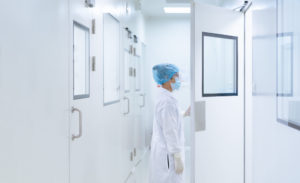
A properly built and functioning cleanroom is vital to the success of many industries. A cleanroom must not attract particles, as that will compromise the results of the work completed in the cleanroom. Allow us to highlight three ways you can reduce the introduction of particles in a cleanroom:
1. Use HEPA or ULPA Filters
The right filters can catch unwanted particles from entering the cleanroom. The recommended filters for a cleanroom are HEPA (high-efficiency particulate air) and ULPA (ultra-low particulate air). These filters can remove contaminants such as:
- Bacteria
- Dander
- Mold spores
- Pollen
2. Wear Proper Clothing & Use an Air Shower
People naturally shed flakes of skin, hair, or particles from their clothing without realizing it. That’s why cleanroom operators must wear special clothing that greatly reduces the opportunity for shedding to occur. Many operators will get dressed in a special room before entering the cleanroom and/or walk through an air shower (forceful bursts of air that removes particles from the user).
3. Right Materials During the Custom Build
Your contractor must use the right materials to build the cleanroom. These materials should be easy to clean and not omit any excessive particles or contaminants. JLJ & Associates have years of experience building cleanrooms, and we are confident that we can build you a cleanroom to your expectations.
Jerry L. Johnson & Associates follows the rules and specifications of building a cleanroom. Call us today with your questions: 770-961-7600
Make sure you check out our previous blog – Cleanroom FAQs – to learn more about cleanrooms and how JLJ & Associates can help you with the creation of this room:
- What does the ISO say about cleanrooms?
- How is cleanliness in a cleanroom determined?
- How do particles enter the cleanroom?
- How do I choose the right contractor to build a cleanroom?

